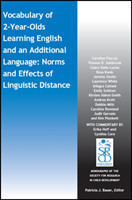The majority of the world’s children grow up learning two or more languages. The study of early bilingualism is central to current psycholinguistics, offering insights into issues such as transfer and interference in development. From an applied perspective, it poses a universal challenge to language assessment practices throughout childhood, as typically developing bilingual children usually underperform relative to monolingual norms when assessed in one language only. We measured vocabulary with Communicative Development Inventories for 372 24-month-old toddlers learning British English and one Additional Language out of a diverse set of 13 (Bengali, Cantonese, Dutch, French, German, Greek, Hindi-Urdu, Italian, Mandarin, Polish, Portuguese, Spanish and Welsh). We furthered theoretical understanding of bilingual development by showing, for the first time, that linguistic distance between the child’s two languages predicts vocabulary outcome, with phonological overlap related to expressive vocabulary, and word order typology and morphological complexity related to receptive vocabulary, in the Additional Language. Our study also has crucial clinical implications: we have developed the first bilingual norms for expressive and receptive vocabulary for 24-month-olds learning British English and an Additional Language. These norms were derived from factors identified as uniquely predicting CDI vocabulary measures: the relative amount of English versus the Additional Language in child-directed input and parental overheard speech, and infant gender. The resulting UKBTAT tool was able to accurately predict the English vocabulary of an additional group of 58 bilinguals learning an Additional Language outside our target range. This offers a pragmatic method for the assessment of children in the majority language when no tool exists in the Additional Language. Our findings also suggest that the effect of linguistic distance might extend beyond bilinguals’ acquisition of early vocabulary to encompass broader cognitive processes, and could constitute a key factor in the study of the debated bilingual advantage.
EAN 9781119507895
ISBN 1119507898
Binding Paperback / softback
Publisher John Wiley and Sons Ltd
Publication date August 10, 2018
Pages 136
Language English
Dimensions 229 x 152 x 7
Country United States
Readership Professional & Scholarly
Authors Abbot-Smith, Kirsten; Cattani, Allegra; Delle Luche, Claire; Floccia, Caroline; Gervain, Judit; Goslin, Jeremy; Krott Andrea; Kwok, Rosa; MILLS, DEBBIE; Plunkett Kim; Rowland Caroline; Sambrook, Thomas D; Sullivan, Emily; White, Laurence
Series editors Bauer Patricia J.
Series Monographs of the Society for Research in Child Development (MONO)













